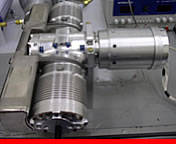1930s aircraft an inspiration for 100 mpg cars
The company, which came out of stealth mode over the weekend, wants to bring what is called an opposed piston/opposed cylinder diesel engine to market. In ordinary engines, pistons pop up and down (or back and forth if laying down) inside an individual cylinder capped by a cylinder head. Gas is injected into the chamber and gets combusted by the action of the piston, among other factors.

A prototype engine from APT
(Credit: APT )In EcoMotors' engine, there is a double-length cylinder with a piston at each end. (There are no cylinder heads in-between.) A single-engine module consists of four pistons and two cylinders, said COO John Coletti. The pistons and cylinders are horizontal too, so car and engine manufacturers can stack them.
The unusual configuration results in several advantages. Mileage can be boosted by 40 percent to 50 percent, when a two-module engine is compared with a standard diesel. The engine also can be made 30 percent lighter. Because the engine modules are horizontal, cars can be more aerodynamic.
Coletti predicted that a 2.5-liter engine from his company will provide the same power as one of the 6.5-liter engines used by truck manufacturers today, but weigh 300 pounds less.
Another advantage: the arrangement of the cylinders causes the vibrations from the engine to cancel each other out. The engine is also well-balanced, he said.
EcoMotors has licensed the concept for an opposed cylinder/opposed piston engine from Advanced Propulsion Technologies, which has been working on the concept for years. (Peter Hofbauer, chairman of APT, is also CEO of EcoMotors). Another licensee of APT will develop engines for the military. That company is expected to deliver a prototype to the Defense Department in May.
"This engine can be used in almost any application. Cars, trucks," said Coletti. The same type of engines could also be used in helicopters, he said.
So, the aircraft bit? Junkers & Co., which designed planes in Germany in the '30s, also used an opposed cylinder/opposed piston design on some engines from 1934 through 1939, Coletti said. The concept never fully took off, however, because it wasn't easy to mass manufacture. APT has figured out ways to reduce parts. Thus, APT and EcoMotors have an engine that's similar in concept but it's different.
"It had two of everything," Colletti said. "This has a single crank shaft."
EcoMotors said in its press release that the company hopes to have something out around 2011, but Coletti said the release depends on a variety of factors.
Copyright ©2008 CNET Networks, Inc. All rights reserved. To subscribe or visit go to: http://www.news.com